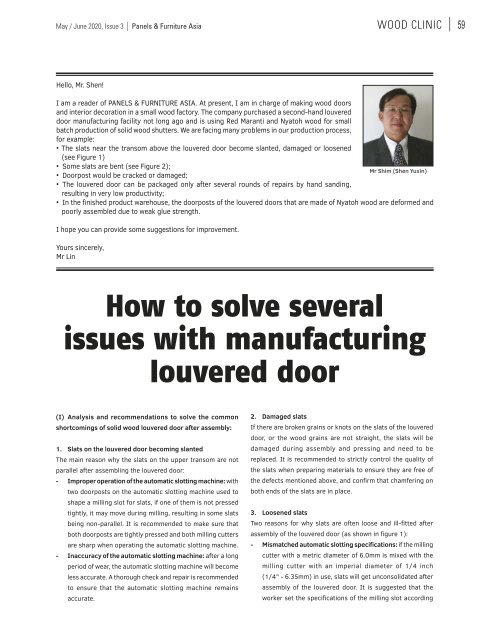Panels & Furniture Asia May/June 2020
Panels & Furniture Asia (PFA) is a leading regional trade magazine dedicated to the woodbased panel, furniture and flooring processing industry. Published bi-monthly since 2000, PFA delivers authentic journalism to cover the latest news, technology, machinery, projects, products and trade events throughout the sector. With a hardcopy and digital readership comprising manufacturers, designers and specifiers, among others, PFA is the platform of choice for connecting brands across the global woodworking landscape.
Panels & Furniture Asia (PFA) is a leading regional trade magazine dedicated to the woodbased panel, furniture and flooring processing industry. Published bi-monthly since 2000, PFA delivers authentic journalism to cover the latest news, technology, machinery, projects, products and trade events throughout the sector. With a hardcopy and digital readership comprising manufacturers, designers and specifiers, among others, PFA is the platform of choice for connecting brands across the global woodworking landscape.
Create successful ePaper yourself
Turn your PDF publications into a flip-book with our unique Google optimized e-Paper software.
<strong>May</strong> / <strong>June</strong> <strong>2020</strong>, Issue 3 | <strong>Panels</strong> & <strong>Furniture</strong> <strong>Asia</strong> WOOD CLINIC | 59<br />
Hello, Mr. Shen!<br />
I am a reader of PANELS & FURNITURE ASIA. At present, I am in charge of making wood doors<br />
and interior decoration in a small wood factory. The company purchased a second-hand louvered<br />
door manufacturing facility not long ago and is using Red Maranti and Nyatoh wood for small<br />
batch production of solid wood shutters. We are facing many problems in our production process,<br />
for example:<br />
• The slats near the transom above the louvered door become slanted, damaged or loosened<br />
(see Figure 1)<br />
• Some slats are bent (see Figure 2);<br />
Mr Shim (Shen Yuxin)<br />
• Doorpost would be cracked or damaged;<br />
• The louvered door can be packaged only after several rounds of repairs by hand sanding,<br />
resulting in very low productivity;<br />
• In the finished product warehouse, the doorposts of the louvered doors that are made of Nyatoh wood are deformed and<br />
poorly assembled due to weak glue strength.<br />
I hope you can provide some suggestions for improvement.<br />
Yours sincerely,<br />
Mr Lin<br />
How to solve several<br />
issues with manufacturing<br />
louvered door<br />
(I) Analysis and recommendations to solve the common<br />
shortcomings of solid wood louvered door after assembly:<br />
1. Slats on the louvered door becoming slanted<br />
The main reason why the slats on the upper transom are not<br />
parallel after assembling the louvered door:<br />
- Improper operation of the automatic slotting machine: with<br />
two doorposts on the automatic slotting machine used to<br />
shape a milling slot for slats, if one of them is not pressed<br />
tightly, it may move during milling, resulting in some slats<br />
being non-parallel. It is recommended to make sure that<br />
both doorposts are tightly pressed and both milling cutters<br />
are sharp when operating the automatic slotting machine.<br />
- Inaccuracy of the automatic slotting machine: after a long<br />
period of wear, the automatic slotting machine will become<br />
less accurate. A thorough check and repair is recommended<br />
to ensure that the automatic slotting machine remains<br />
accurate.<br />
2. Damaged slats<br />
If there are broken grains or knots on the slats of the louvered<br />
door, or the wood grains are not straight, the slats will be<br />
damaged during assembly and pressing and need to be<br />
replaced. It is recommended to strictly control the quality of<br />
the slats when preparing materials to ensure they are free of<br />
the defects mentioned above, and confirm that chamfering on<br />
both ends of the slats are in place.<br />
3. Loosened slats<br />
Two reasons for why slats are often loose and ill-fitted after<br />
assembly of the louvered door (as shown in figure 1):<br />
- Mismatched automatic slotting specifications: if the milling<br />
cutter with a metric diameter of 6.0mm is mixed with the<br />
milling cutter with an imperial diameter of 1/4 inch<br />
(1/4" - 6.35mm) in use, slats will get unconsolidated after<br />
assembly of the louvered door. It is suggested that the<br />
worker set the specifications of the milling slot according


















